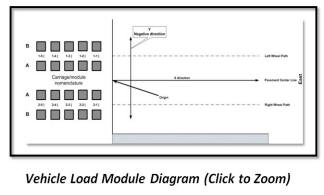The test vehicle is programmed for a controlled aircraft wander simulation and can operate in manual or fully automatic modes and capable of a speed of up to 15 miles per hour. The maximum speed however, has been limited (hard coded) to 5 miles per hour.
Carriages and Load Modules

The test vehicle is comprised of two carriages that can accommodate up to five load modules each. Each load module has two wheels. This allows for configurations of up to 20 wheels with loads up to 75,000 pounds (333.75 kN) per wheel.
The north carriage is designated "Carriage 1", the south carriage is designated "Carriage 2". The east-most load module on each of the carriages is numbered "1"; the west-most load module on each of the carriages is numbered "5". Therefore, load module 1-1 is on the north carriage and faces the east end of the facility. Similarly, load module 2-5 is on the south carriage and faces the west end of the facility. Inner wheels are desinated as "A" and outer wheels as "B". Each of the load modules can be operated independently to simulate 1, 2, 4, 5, 6, 8, or 10 wheel loads per carriage.
Dual wheel spacing on each of the modules can be adjusted with axle replacements. Tandem spacing of the modules can be set by using different lateral mounting positions on the carriage. Simulation of a single wheel load requires the installation of a single wheel module.
During construction cycles 1 and 3, only 2-wheel modules were installed. Specific wheel load configurations are published under each construction/traffic testing cycle.
Vehicle Wander

Vehicle Wander. The pavement test vehicle simulates realistic aircraft wander by varying the lateral (y) position of the carriages to simulate a normal distribution of aircraft traffic during traffic testing. The wander pattern used for the majority of the traffic testing consists of 66 vehicle passes, arranged in 9 wander positions (or tracks). The wander positions and sequences were chosen to simulate a normal distribution of aircraft traffic with a standard deviation of 30.5 inches (representing the current design condition for airport taxiways). Normally, the same wander is used on both carriages and it is changed at one end of the test pavement. Specific wander patterns are published under each construction/traffic testing cycle.